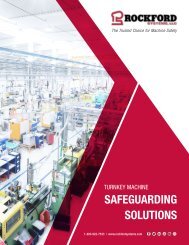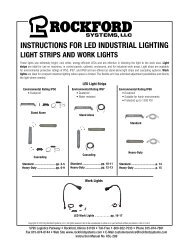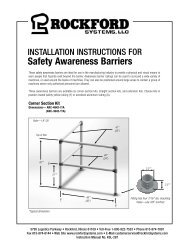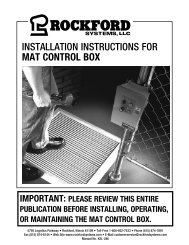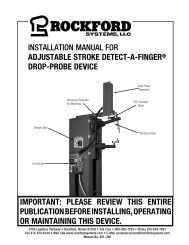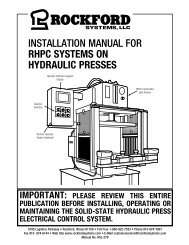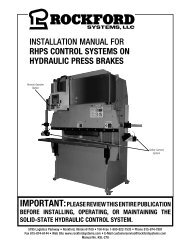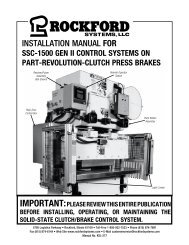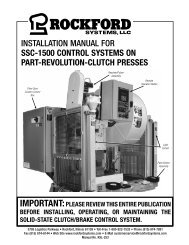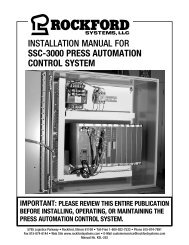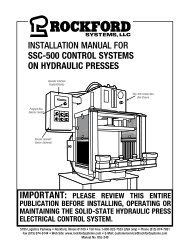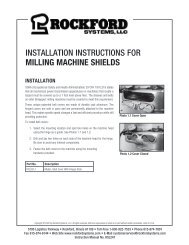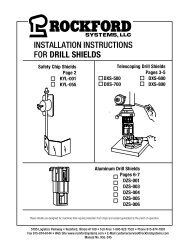Rockford Systems Control Systems for Presses Catalog
Catalog for control systems for mechanical power presses and press brakes, and hydraulic power presses and press brakes. These control systems are designed and built to comply with applicable OSHA regulations and ANSI standards. The catalog goes into detail about the features of the systems, and describes the different options available to update or replace existing control systems. This catalog also includes spring-loaded turnover bars, palm button assemblies, danger signs, and a section with helpful references. The catalog is divided into sections that offer control systems and components for: - Full-Revolution-Clutch Presses - Part-Revolution-Clutch Presses and Press Brakes - Hydraulic Presses and Press Brakes - Press Automation Control
Catalog for control systems for mechanical power presses and press brakes, and hydraulic power presses and press brakes. These control systems are designed and built to comply with applicable OSHA regulations and ANSI standards. The catalog goes into detail about the features of the systems, and describes the different options available to update or replace existing control systems. This catalog also includes spring-loaded turnover bars, palm button assemblies, danger signs, and a section with helpful references.
The catalog is divided into sections that offer control systems and components for:
- Full-Revolution-Clutch Presses
- Part-Revolution-Clutch Presses and Press Brakes
- Hydraulic Presses and Press Brakes
- Press Automation Control
Create successful ePaper yourself
Turn your PDF publications into a flip-book with our unique Google optimized e-Paper software.
MECHANICAL POWER PRESS CONTROL SYSTEMS<br />
Each mechanical power press must be looked at as an individual<br />
system. This system consists of, but is not limited to, the frame, all<br />
mechanical parts, clutch and brake assemblies, electrical or electronic<br />
systems, hydraulic systems, pneumatic systems, tooling or dies<br />
(present and future), tool or die setup, safeguarding, material handling,<br />
maintenance requirements, size or configuration of workpiece, and most<br />
importantly, production requirements.<br />
OSHA STANDARDS<br />
The controls and safeguarding systems offered in this section of the<br />
catalog will help the user of mechanical power presses (punch presses)<br />
meet or exceed OSHA 29 CFR 1910.212, 1910.217, 1910.219,<br />
1910.147 and ANSI B11.1 safety standards as we interpret them.<br />
OSHA’s Code of Federal Regulations can be purchased by contacting:<br />
U.S. Government Printing Office<br />
P.O. Box 371954<br />
Pittsburgh, PA 15250-7954<br />
(202) 512-1800<br />
http://bookstore.gpo.gov<br />
ANSI STANDARDS<br />
There are several references available on press safety; however, most<br />
industries use the ANSI (American National Standards Institute) B11.1<br />
standard <strong>for</strong> the best safety practice on power presses. This standard<br />
can be purchased by contacting:<br />
ANSI<br />
American National Standards Institute, Inc.<br />
25 West 43rd Street, 4th Floor<br />
New York, New York 10036<br />
(212) 642-4900<br />
www.ansi.org<br />
TYPES OF CLUTCHES ON PRESSES<br />
Most power presses have one of two types of clutches:<br />
1. Full Revolution (sometimes referred to as a mechanical clutch)<br />
2. Part Revolution, classified in two categories:<br />
— Air Clutch<br />
— Mechanical-Friction Clutch<br />
CONDITION OF THE PRESS<br />
The equipment offered in this catalog can neither cure nor overcome a<br />
malfunctioning machine or prevent a mechanical defect or failure of a<br />
component part thereof, nor prevent a repeat or unintended stroke (cycle)<br />
resulting from a mechanical malfunction, defect or failure of the machine<br />
itself.<br />
For example, on mechanical power presses, a brake monitoring system<br />
can only detect a gradual deterioration of the brake on the press, not a<br />
catastrophic mechanical failure in the clutch/brake mechanism.<br />
It is essential that the machine be thoroughly inspected and that all<br />
mechanical, electrical, pneumatic, and hydraulic components and<br />
systems, including all collateral equipment, be in first-class operating<br />
condition be<strong>for</strong>e any equipment is installed. A maintenance and<br />
inspection program must be established and implemented to keep<br />
machines in your plant in first-class condition. This program must<br />
include regular periodic inspections of each machine to ensure that,<br />
among other things, (i) the clutch and brake mechanism, mechanical<br />
linkages, and air counterbalances are operating and used properly; (ii)<br />
there is no dirt or water in the air lines; and (iii) the machine is operating<br />
at its proper speed (RPM or SPM). Any part of the machine that is worn,<br />
damaged, or not operating correctly must immediately be replaced or<br />
repaired be<strong>for</strong>e the machine is used.<br />
6 | CONTROL SYSTEMS




